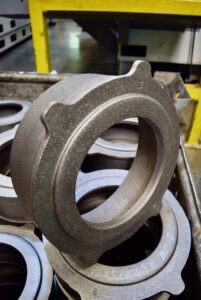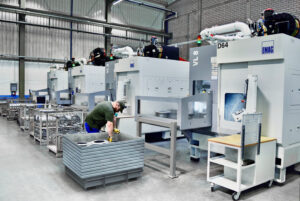In the heart of the Eifel region, around 50 kilometers from Koblenz, Bharat Forge Daun mechanical production works at the highest level, producing extremely precise, rotationally symmetrical series components, among other things. This means that challenges like difficult surfaces and positional arrangements are common. Several EMAG machines are currently being used in the production of a stator housing for electromobility – with a focus on process reliability. In the following interview, Christoph Steffens, Head of Mechanical Production at Bharat Forge Daun, explains the reasons for using EMAG machines and why EMAG service is so important.
Mr. Steffens, what distinguishes the company’s expertise?

Christoph Steffens, Head of Mechanical Engineering at Bharat Forge Daun.
On the one hand, we are responsible for the production of forging tools, which are used at Bharat Forge’s German sites, for example. On the other hand, we produce rotationally symmetrical components for the automotive industry, general mechanical engineering, the construction of agricultural machinery and similar sectors. Many of these components have a pot-like shape, which presents a machining challenge. A great deal of experience and expertise in detail is required. In this context, we monitor the processes very comprehensively, carry out many measurements and even accompany the component development if required – so that the production of the component runs efficiently.
Why are various EMAG machines used in the production of a stator housing for electromobility?
We have been producing the housing for around five years, starting with a forged steel blank. This is a rarity in this area of application. We rely on VL machines from EMAG, among others, because the machines are extremely robust and fast.

The blank is a forged steel component – a rarity in the “stator housing” application area.
Were there other reasons?
Firstly, EMAG was one of the few machine manufacturers that was able to demonstrate to us, using the example of another user, how successfully a stator housing is machined in its machines. Secondly, EMAG’s pick-up concept is also a great advantage compared to the automation of horizontal machines.

Four VL 8s from EMAG carry out the rough-machining processes on the component.
EMAG’s technology has been in use for some time now. What is your impression?
The entire solution is very robust and reliable – and that was precisely our aim when we made the investment decision. So far, we have only had minor problems, but a local EMAG service technician has always been on site and quickly rectified the fault. In my opinion, this proximity of service is a very strong argument for EMAG.